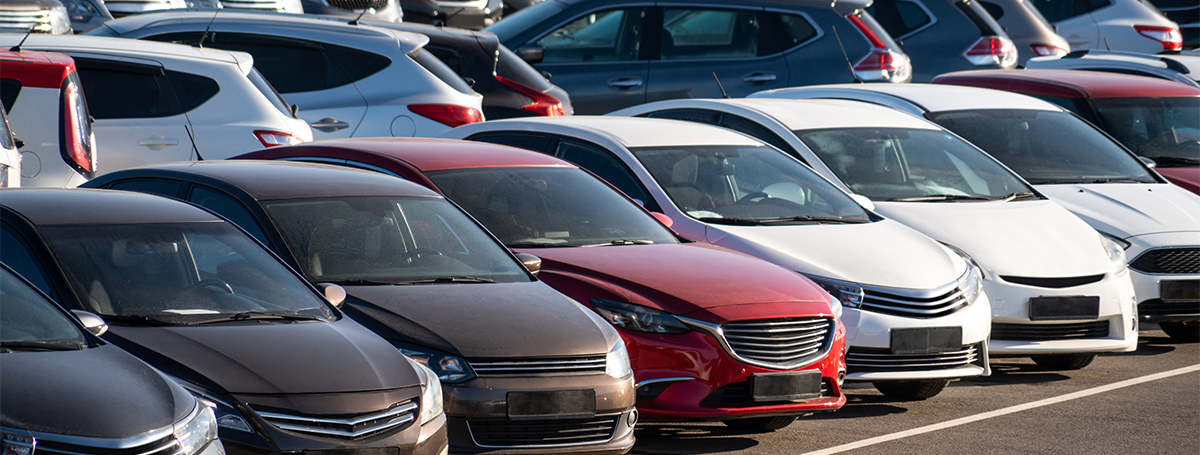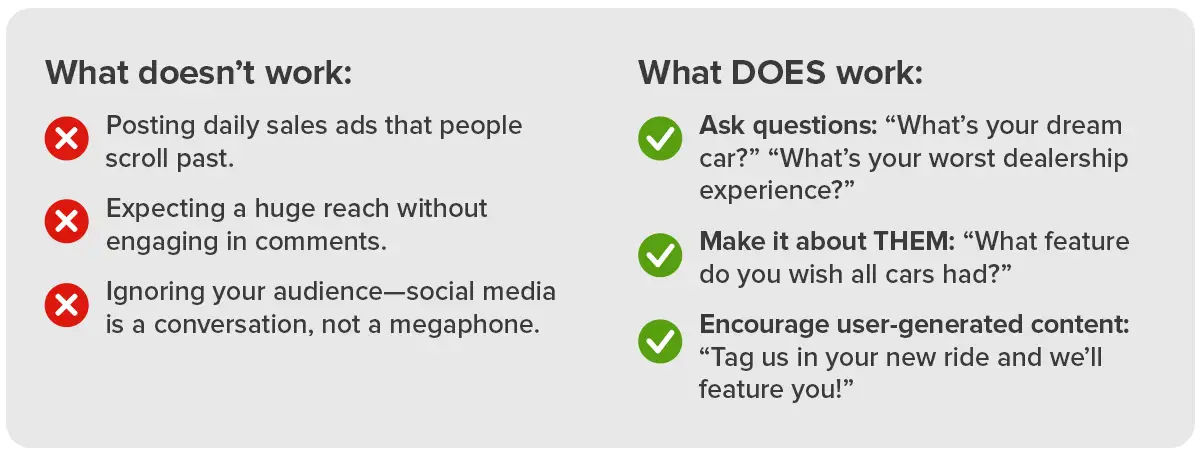For most dealerships, social media is just a digital version of their lot—filled with inventory photos, lease specials, and generic “Check out this new arrival!” posts. The problem? That’s not why people are on social media.
Customers already know you have cars for sale. They don’t need another post reminding them that you sell trucks or that you have the “hottest deals of the season.” What they do want is to feel connected, informed, and confident about their dealership choices.
The dealerships that are truly winning on social media aren’t just posting cars—they’re building relationships. They’re showing the faces behind the dealership, engaging their local community, and making car buying and servicing less intimidating and more approachable.
If your social media isn’t driving engagement, repeat customers, and brand loyalty, it’s time to rethink your approach. Here’s how to shift from sales-y posts to content that keeps customers coming back.
In a recent episode of Retention Roadmap, we sat down with Savannah Simms, Director of Marketing & Business Development at Simms Auto Group (and COO at Freddy Media), to discuss how dealerships can ditch ineffective sales posts, leverage social media influencers, and use AI the right way to build long-term customer loyalty.
1. Stop posting inventory like it’s 2010

Social media has changed. A decade ago, just posting pictures of cars might have gotten you some engagement. But now? It’s background noise.
Customers assume you have the latest models because you’re a dealership. Posting “Check out the new 2025 Toyota Highlander!” doesn’t excite anyone. They know you have it. What they don’t know is:
- Why should they trust you over the dealership down the road?
- What makes your team different?
- Who are they actually going to interact with when they come in?
🚫 What not to post:
- Generic stock photos of vehicles.
- “Just Arrived” posts with no personality or value.
- Inventory lists with zero context.
✅ What to post instead:
- Behind-the-scenes content: Show what happens before a car gets to the lot. Walk customers through the reconditioning process for used cars or show how your team preps a new car for delivery.
- Customer stories: Feature real customers picking up their vehicles, but focus on their experience, not just the car. “Why did John choose this truck? What problem did it solve for him?”
- Comparisons & insights: Instead of saying, “We have the new 2025 Highlander,” try “Here’s how the 2025 Highlander stacks up against last year’s model.”
Example: Instead of posting “Just Arrived! New Silverados in stock!” try:
- “Is the Silverado or F-150 the better truck for towing? Here’s what our experts say.”
- “Five things people always get wrong about the Silverado—are you making these mistakes?”
This shifts the focus from what you’re selling to why customers should care.
2. What the best dealerships do differently
The dealerships winning on social media aren’t just spamming cars—they’re building a brand.
Great dealership social media feels like following a personality, not a company. Some do this through humor, some through education, and some through community engagement.
Standout examples:
- Mohawk Chevrolet made yellow rubber duckies part of their brand. Every customer gets one, and it became a viral symbol of their dealership.
- Camino Chevrolet in Los Angeles built a cast of characters from their team, making their showroom feel like a reality TV show.
- Russ Flips Whips balances humor and education, turning car sales into relatable and entertaining content.
What your dealership can do:
- Give your store a personality—whether that’s funny, educational, or community-driven.
- Feature your team—let customers see and hear from service advisors, techs, and managers.
- Make it interactive—polls, Q&As, behind-the-scenes videos, and customer features.
Example: Instead of posting a plain car photo, introduce your team:
- “Meet Lisa, our sales consultant who helps first-time buyers feel at home. Her #1 tip for stress-free car buying? DM us to find out!”
It’s human. Relatable. Engaging.
3. Focus on engagement, not just views
Many dealerships think likes and followers equal success. But engagement is more important than reach. You want people commenting, sharing, and interacting—because that’s what builds relationships.

Example:
Instead of:
🚫 “Lease the new 2025 Camry for $399/month!”
Try:
✅ “Which car do you think has the best interior for long road trips? Drop your thoughts!”
This sparks conversation instead of feeling like an ad.
4. Optimize for short-form content
Short-form video (TikTok, Instagram Reels, YouTube Shorts) is dominating social media. Dealerships that aren’t using it are missing out on the most effective format for engagement.
What to Film:
- Techs explaining common service issues (“Here’s what your check engine light could mean”).
- Behind-the-scenes content (new car arrivals, funny dealership moments).
- Day in the life videos (“What it’s really like to work at a dealership”).
- Comparisons (“Ford vs. Chevy: Which truck lasts longer?”).
Example:
Instead of posting a plain photo of a truck, post a video:
- “Here’s why truck owners are obsessed with this hidden feature.”
- “Can this truck really tow as much as it claims? We put it to the test.”
Pro tip: If you record a long video (like a dealership podcast), chop it up into multiple short clips to maximize content.
5. Drive better fixed ops engagement
Most dealerships focus their marketing on selling cars—but service and maintenance are where real retention happens. The key to keeping customers coming back isn’t just price or promotions—it’s engagement and transparency.
Make fixed ops fun
The service department doesn’t have to be a mystery. Customers want to understand their vehicle’s maintenance, and social media is the perfect place to educate them.
What Works:
- Techs breaking down common service issues (“Here’s what happens when you ignore an oil change”).
- Before-and-after repairs (“This customer waited too long to replace their brakes—check out the difference”).
- Shop culture content—team-building projects, open house events, or funny day-in-the-life clips.
Example: One dealership started a monthly open house where high school students could meet technicians, ask questions, and learn about careers in auto service—turning recruiting into marketing.
Build trust through education
Most customers don’t trust service departments. Change that by being upfront and teaching them what they need to know.
Content Ideas:
- “Why do dealerships recommend OEM parts over aftermarket? Here’s the difference.”
- “What your technician sees when inspecting your tires—here’s what we look for.”
When customers feel informed and involved, they’re far more likely to return to your service department instead of a competitor.
When dealerships start thinking like content creators instead of advertisers, social media becomes one of their best tools for customer retention and brand loyalty.
Artificial intelligence & influencers—the future of dealership marketing?
Social media and AI are changing the game for dealerships—but how much of it is hype, and how much can actually help you sell more cars and retain more customers?
In the full Retention Roadmap episode, we dive into a whole lot more, along with:
- The rise of dealership influencers—how real people (not corporate ads) are driving engagement and trust.
- How AI can actually help—from automating content creation to improving customer follow-ups.
- What dealerships get wrong—common mistakes in both influencer marketing and AI-driven automation.
🎧 Listen to the full episode to learn how to use these tools the right way—and what to avoid.

